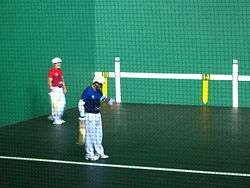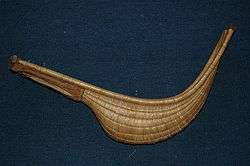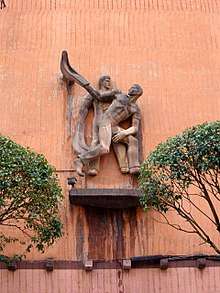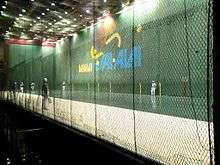Jai alai
Jai alai (/ˈhaɪ.əlaɪ/: [ˈxai aˈlai]) is a sport involving a ball that is bounced off a walled space by accelerating it to high speeds with a hand-held wicker device (cesta). It is a variation of Basque pelota. The term, coined by Serafin Baroja in 1875, is also often loosely applied to the fronton (the open-walled playing area) where the sport is played. The game is called "zesta-punta" (basket tip) in Basque. The sport is played in Spain, south west of France and Latin American countries.
 Jai alai play in progress | |
| First played | 14th century |
|---|---|
| Characteristics | |
| Contact | No |
| Team members | Various |
| Type | Indoor–outdoor |
| Equipment | pelota, xistera/cesta |
Rules and customs

The court for jai alai consists of walls on the front, back and left, and the floor between them. If the ball (called a pelota, "ball" in Standard Basque) touches the floor outside these walls, it is considered out of bounds. Similarly, there is also a border on the lower 3 feet (0.9 m) of the front wall that is also out of bounds. The ceiling on the court is usually very high, so the ball has a more predictable path. The court is divided by 14 parallel lines going horizontally across the court, with line 1 closest to the front wall and line 14 the back wall. In doubles, each team consists of a frontcourt player and a backcourt player. The game begins when the frontcourt player of the first team serves the ball to the second team. The winner of each point stays on the court to meet the next team in rotation. Losers go to the end of the line to await another turn on the court. The first team to score 7 points (or 9 in Superfecta games) wins. The next highest scores are awarded "place" (second) and "show" (third) positions, respectively. Playoffs decide tied scores.
A jai alai game is played in round robin format, usually between eight teams of two players each or eight single players. The first team to score 7 or 9 points wins the game. Two of the eight teams are in the court for each point. The server on one team must bounce the ball behind the serving line, then with the cesta "basket" hurl it towards the front wall so it bounces from there to between lines 4 and 7 on the floor. The ball is then in play. The ball used in jai alai is hand crafted and consists of metal strands tightly wound together and then wrapped in goat skin. Teams alternate catching the ball in their (also hand crafted) cesta and throwing it "in one fluid motion" without holding or juggling it. The ball must be caught either on the fly or after bouncing once on the floor. A team scores a point if an opposing player:
- fails to serve the ball directly to the front wall so that upon rebound it will bounce between lines No. 4 and 7. If it does not, it is an under or over serve and the other team will receive the point.
- fails to catch the ball on the fly or after one bounce
- holds or juggles the ball
- hurls the ball out of bounds
- interferes with a player attempting to catch and hurl the ball
The team scoring a point remains in the court and the opposing team rotates off the court to the end of the list of opponents. Points usually double after the first round of play, once each team has played at least one point. When a game is played with points doubling after the first round, this is called "Spectacular Seven" scoring.
The players frequently attempt a "chula" shot, where the ball is played off the front wall very high, then reaches the bottom of the back wall by the end of its arc. The bounce off the bottom of the back wall can be very low, and the ball is very difficult to return in this situation.
Since there is no wall on the right side, all jai alai players must play right-handed (wear the cesta on their right hand), as the spin of a left-handed hurl would send the ball toward the open right side.[1]
The Basque Government promotes jai alai as "the fastest sport in the world" because of the speed of the ball. The sport once held the world record for ball speed with a 125–140 g ball covered with goatskin that traveled at 302 km/h (188 mph), performed by José Ramón Areitio at the Newport, Rhode Island Jai Alai, until it was broken by Canadian 5-time long drive champion Jason Zuback on a 2007 episode of Sport Science with a golf ball speed of 328 km/h (204 mph).
The sport can be dangerous, as the ball travels at high velocities. It has led to injuries that caused players to retire and fatalities have been recorded in some cases.[2][3]
Industry
Jai alai is a popular sport within the Latin American countries and the Philippines from its Hispanic influence. It was one of the two gambling sports from Europe, the other being horse racing, in the semi-colonial Chinese cities of Shanghai and Tianjin, and was shut down after the communist victory there. The jai alai arena in Tianjin's former Italian Concession was then confiscated and turned into a recreation center for the city's working class.
The Philippines
Jai alai was played in Manila at the Manila Jai Alai Building, one of the most significant Art Deco buildings in Asia, which was torn down in 2000 by the Manila city government.[4] In 1986, jai alai was banned in the Philippines because of problems with game fixing.[4] However, jai alai returned to the Philippines in March 2010. In 2011, jai-alai was briefly shut down in the province of Pangasinan because of its connection to illegal jueteng gambling but was reopened after a court order.[5]
United States


In the United States, jai alai enjoyed some popularity as a gambling alternative to horse racing, greyhound racing, and harness racing, and remains popular in Florida, where the game is used as a basis for Parimutuel betting at six frontons throughout the state: Dania Beach, Fort Pierce, Jasper, Casselberry, Miami, and Reddick.
The first jai alai fronton in the United States was located in St. Louis, Missouri, operating around the time of the 1904 World's Fair. The first fronton in Florida opened at the site of Hialeah Race Course near Miami (1924). The fronton was relocated to its present site in Miami near Miami International Airport. Year-round jai alai operations include Miami Jai-Alai Fronton (the biggest in the world with a record audience of 15,502 people on 27 December 1975) and Dania Jai Alai. Seasonal facilities are Fort Pierce Jai Alai, Ocala Jai Alai and Hamilton Jai Alai. The Tampa Jai Alai operated for many years before closing in the late 1990s. Inactive jai alai permits are located in Tampa, Daytona Beach, West Palm Beach, and Quincy. One Florida fronton, in Melbourne, was converted from jai alai to greyhound racing.
By contrast, jai alai's popularity in the northeastern and western United States waned as other gambling options became available. In Connecticut, frontons in Hartford and Milford permanently closed, while the fronton in Bridgeport was converted to a greyhound race track. In 2003, the fronton at Newport Jai Alai in Newport, Rhode Island was converted into Newport Grand, a slot machine and video lottery terminal parlor, which closed permanently in August 2018.[7] Jai alai enjoyed a brief and popular stint in Las Vegas with the opening of a fronton at the MGM Grand Hotel and Casino; however, by the early 1980s the fronton was losing money and was closed by MGM Grand owner Kirk Kerkorian. The MGM Grand in Reno also showcased jai alai for a very short period (1978–1980).[8][9]
After the 1968 season, players returned home and threatened not to come back unless the owners improved their work conditions. The owners, however, offered the same terms and started hiring inexperienced players instead of the world-class stars. The public did not notice the change. Later strikes were placated with salary rises. In 1988–1991, the International Jai-Alai Players Association held the longest strike in American professional sport. The owners substituted with Americans raised locally, while the strikers picketed the courts for years. The players, 90% Basques, felt insecure submitted to the will of their employers. Spain was no longer a poor conservative country and the new generation of players were influenced by leftist Basque nationalism. The strike ended with an agreement between the parts. Meanwhile Native American casinos and state lotteries had appeared as an alternative to jai-alai betting. [10]
In an effort to prevent the closure of frontons in Florida, the Florida State Legislature passed HB 1059, a bill that changed the rules regarding the operation and wagering of poker in a Pari-Mutuel facility such as a jai alai fronton and a greyhound and horseracing track. The bill became law on August 6, 2003. However, while in the 50s to the 80s a game had 5,000 spectators, nowadays it does not go beyond 50.[10]
Although the sport has been in decline in America for several years, the first public amateur jai alai facility was built in the United States in 2008, in St. Petersburg, Florida, with the assistance of the city of St. Petersburg and private funding from Jeff Conway (Laca). Jai alai is virtually unknown in the western United States but still maintains some popularity in parts of the Northeast.
Amateur jai-alai
In addition to the amateur court in St. Petersburg, The American Jai-Alai Foundation offers lessons. Its president, Victor Valcarce, was a pelotari at Dania Jai-Alai (MAGO #86) and was considered the best "pelota de goma" (rubber ball) player in the world. Sponsored in North Miami Beach, Florida which was once owned by World Jai-Alai as a school that, in 1972, produced the greatest American pelotari, Joey Cornblit #37.[11]
During the late 1960s, in addition to North Miami Amateur, there was at least one other amateur court from International Amateur Jai-Alai in South Miami professional players that emerged including "RANDY" #44 at World Jai-Alai, regarded as the first American pelotari who turned pro in 1968 and enjoyed a lengthy career. In the 1970s and early 1980s Orbea's Jai-Alai in Hialeah featured four indoor courts. Two of the courts played with hard rubber balls ("pelota de goma") were shorter than a standard court (75' / 90') and used for training players and amateur leagues. There were also two courts played with the regulation pelota (hardball / "pelota dura"), one short in length (115') and one regulation length (150'). Orbea's also sold equipment such as cestas and helmets.
Retired players visited and played as well as highly skilled amateurs, pros from Miami Jai-Alai and various other professional frontons operating at the time. What the South Miami, North Miami, Orbea and later the Milford amateur courts contributed to what is thought to be the golden age of the amateur jai-alai player and the sport in the United States is impressive. In the late 1980s at least one other amateur court was constructed in Connecticut.
At Dania Jai Alai, there is a "Hall of Fame" to document the best front and back court players.
See also
References
- Skiena, Stephen. Calculated bets: computers, gambling, and mathematical modeling to win, p. 25
- Steven, Skiena (2001). Calculated Bets. United States of America: Cambridge University Press. p. 24. ISBN 0-521-00962-6.
Since the 1920s at least four players have been killed by an jai alai ball...
- "The History and Return of Jai Alai - The Art of Manliness". 19 November 2009. Retrieved 1 May 2018.
- Villalon, Toti (July 15, 2012). "Remember jai alai: Stop making Manila heritage demolition victim". Philippine Daily Inquirer. Retrieved 30 August 2012.
- Philippine News Agency (September 7, 2011). "Jai-alai back with vengeance in Pangasinan". InterAksyon.com The online news portal of TV5. Archived from the original on 13 December 2012. Retrieved 30 August 2012.
- "WHAT HAPPENED TO JAI ALAI?". SB Nation. 2013-02-28.
- Flynn, Sean. "Site of Newport Grand, which closes Tuesday, has had many lives". The Newport Daily News. Retrieved 27 August 2018.
- Kleiner, Dick (Aug 20, 1978). "Reno Gambles On Future". The Prescott Courier.
- "Jai-Alai Chronology – Significant Dates".
- A Basque-American Deep Game: The Political Economy of Ethnicity and Jai-Alai in the USA, Olatz González Abrisketa, pp. 179–198, Studia Iberica et Americana 4, December 2017 ISSN 2327-476X
- "Sport: Did Joey Eat?". Time. 30 January 1978.
External links
| Wikimedia Commons has media related to Jai alai. |
- "The History of basque Pelota in the Americas" by Carmelo Urza
- 30 for 30: What the Hell Happened to Jai Alai? ESPN short on YouTube
- Jai Alai Blues on IMDb
- Jai Alai Blues at Euskal Telebista's video-on-demand service (in Spanish)
- Slow death of a fast game, The Observer, July 2009
- Frontons.net is a collaborative project aimed at identifying and geotagging open-air single walled fronton around the world.
- Forgotten – documentary about the decline of Jai alai in Miami
